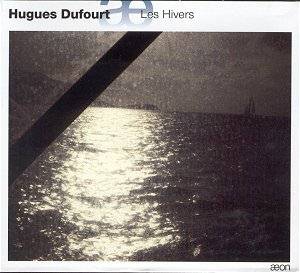Dufourt’s status in French contemporary music must
be unique, in that he was trained in Geneva studying piano with Louis
Hiltbrand and composition with Jacques Guyonnet while pursuing academic
studies in philosophy which he later taught in several French universities.
Music, however, was and remained a major concern and he painstakingly
composed a sizeable body of substantial works. These include an opera
Dédale first performed in 1995, a large-scale work
Erewhon written for Les Percussions de Strasbourg and
several pieces inspired by visual artists, such as L’Orage
(after Giorgione), La Maison du sourd (after Goya), Lucifer
d’après Pollock, Hommage à Charles Nègre
(originally a score for a film inspired by a photograph by Nègre)
and the large-scale cycle recorded here Les Hivers.
Dufourt’s approach, however, excludes any attempt at
easy pictoralism and superficial description. His works, inspired either
by paintings or photographs, are essentially abstract pieces of music.
He, more than anyone else, is fully conscious of the totally diverging
nature of painting (or photography) and music, and of the difficulty,
let alone the impossibility in bridging the gap between them. The former
is primarily static, even when depicting movement as in Poussin’s Le
Déluge or in Brueghel’s Les Chasseurs dans la neige,
and suggests movement by working on our imagination. The latter, on
the contrary, is essentially dynamic, unfolding in time, thus implying
a beginning and an end. To a certain extent, Dufourt’s music may be
experienced as an attempt at some reconciliation between the two art
forms while relying solely on musical parameters. His generally slow
moving music is often underpinned by considerable activity, as it were,
under the surface.
The cycle Les Hivers was inspired by paintings
by Rembrandt, Brueghel, Poussin and Guardi, all directly or indirectly
related to winter and all having some symbolic meaning of their own
reflected in the music, although – as already mentioned – the pieces
are first and foremost abstract musical structures eschewing any directly
descriptive elements.
Le Philosophe after Rembrandt was completed
in 1992 whereas the other panels were completed almost ten years later.
Le Philosophe was actually performed separately some time
after its completion while the whole cycle was first performed complete
in 2002. Le Philosophe is a perfect example of Rembrandt’s clair-obscur.
The philosopher sits in front of the brightly sunlit window. The left
corner of the room is in darkness whereas a spiralling staircase dimly
lit by the sunlight occupies the right side of the painting. The piece
falls into three sections played without a break, thus reflecting the
painting’s structure. It opens in mysterious, dark tones progressively
leading into the somewhat brighter central section in turn leading into
the final section characterised by spiralling whiffs of tunes alluding
to the staircase depicted in the painting. The music moves at a quite
moderate tempo throughout, in limited dynamics, thus adequately equalling
the meditative nature of Rembrandt’s painting. When the whole cycle
was completed, Le Philosophe was placed second, as a slow
movement, preceded by Le Déluge after Poussin.
This fairly long movement also moves at a moderate tempo, but suggestions
of the storm are achieved principally by slowly increasing dynamics
and thicker textures leading to a comparatively short climax characterised
by intensity rather than by rhythmical activity. The first panels, Le
Déluge and Le Philosophe, are of fairly
equal length (they both play for about forty minutes) and are followed
by two shorter movements, of which the first Les Chasseurs dans
la neige after Brueghel’s wonderful painting (a favourite of
mine) acts as a Scherzo of some sort. The music here has more variety
and even brightness. The movement opens with a slow introduction depicting,
so to say, the global impression left by a first, superficial glance
at the painting. Then, the eye leisurely travels through it; and, with
human beings in the foreground (the hunters) and in the background (villagers,
skaters), the music becomes brighter and somewhat more realistic without
ever becoming descriptive. The movement ends, as it had begun, in wintry
tones. Guardi’s La Gondole sur la lagune is predominantly grey.
The outline of the city dimly emerges through the foggy background.
The centre is entirely occupied by the grey waters of the lagoon with
a black gondola (La Lugubre Gondole) in the foreground. Music
of immobility in total accord with the painting’s essentially static
quality.
Dufourt’s music is, as I have already mentioned, predominantly
slow, often confined to limited dynamics and free of any descriptive
elements (though the latter may sometimes briefly surface). It slowly
unfolds as some labyrinthine ritual, and makes its points through subtle
dynamic shadings, refined harmony and telling instrumental groupings
without ever resorting to thematic or contrapuntal working of any sort.
The most remarkable thing about it, I think, is that despite the acute
intellectual conception "behind the music" it is quite gripping
and calmly communicative, though it only yields its secrets on repeated
hearings. I am in no doubt that Les Hivers is a major
musical achievement of the late 20th Century.
The present performance of the complete cycle was recorded
live during the opening concert of the 2002 Ars Musica festival in Brussels,
but you would never guess it, were it not for the final applause greeting
this very fine performance. There is hardly any background noise (sometimes
musicians may be heard turning their pages) and the recorded sound is
really quite good. The production is excellent (I have come to regard
this as a hallmark of this new label’s releases) with many interesting
notes, some of which are by the composer, but I would suggest that you
listen to the music first and then read the notes. AEON deserve our
gratitude for this brave venture and for thus allowing repeated hearings
of this complex, but ultimately highly rewarding major work.
Hubert Culot

